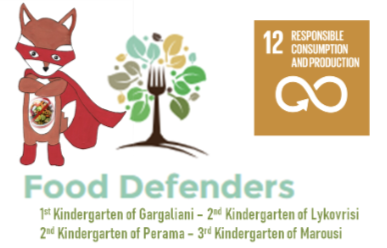
by Angeliki Liapi (2nd Kindergarten of Lykovrisi), Maria Tsapara (2nd kindergarten of Perama), Anthi Arkouli (Kindergarten of Nea Penteli)
Introduction
The project Food Defenders: Make the Waste to Worth the Taste, was designed and applied in four Kindergartens (5 classes) from Greece, nine teachers and 109 children participated. The mascot of the programme Foxie Planet invited students to adopt new attitudes towards food waste reduction. The accumulation of large amounts of waste in the classroom bin during lunch motivated children to search for solutions regarding the rational use of these resources and their recycling. The combination of environmental and STEAM education cultivates skills related to creativity, critical thinking, communication, and collaboration within an inquiry learning framework.
Circular Economy
The circular economy responds to the principles of sustainable development and is adopted by many countries now. The circular economy comes as a response to the ambition for sustainable development, the growing concerns about the depletion of natural resources, and the degradation of the environment.
According to this, the project "Make the Waste Worth the taste" was framed by activities that were designed and implemented in the context of exploratory learning. Activities that make children and their families aware of the need to reduce food waste and to reconstruct and reprocess it as something new (leftover recipes).
Project goals and connection to the new curriculum for Kindergarten
In terms of core knowledge:
Children understood that their personal choices have an environmental impact and that it is necessary to participate in the environmental making decission process.
In terms of skills:
Τhe need to explore and document the factors that shape individual and social experience and are linked to human activity was fostered. In order to choose the appropriate ways of communicating and conveying the message and adapting behaviour to the circumstances at any given time. We wanted to cultivate the use of specialized vocabulary to collect, analyze, interpret and present data in multiple formats, to formulate and test hypotheses, to make quantitative, qualitative and causal connections, to choose the optimal solution (decision) and to formulate conclusions concerning the individual and the group, for responsible behavior.
In terms of attitudes:
emphasis was placed on self-understanding and the importance of positive interaction with other people, dealing with diversity as an advantage for personal and social development (food-nutrition culture), the development of universal values, such as responsibility, respect , solidarity, the utilization of scientific knowledge for the understanding of the natural, technological and social world, the positive attitude and responsible action towards the environment, the responsible attitude towards problems and the application of democratic processes in decisions, the critical attitude and active action for sustainable development.
Methodology
The project aims to raise awareness about food waste and engage students in a discussion to reduce overconsumption and build sustainable societies. Through this project, which is based on the 12th goal for sustainable development and lifestyle, students will develop their understanding of how food waste contributes to climate change. They will have an opportunity to identify potential problems or areas where an invention (composter) could help reduce the amount of food we waste. This activity engages students in STEAM methodology – Science (climate change), Technology (Edison robot programming, Makey-Makey), Εngineering (composter, board game), Art (recipe book, sustainable artwork), and Mathematics (measuring system to weigh leftovers).
Research questions
- Do we waste food?
- How much food do we waste in our classroom?
- How can we reduce food waste?
A form on Google docs was created to collect data and figure out how much food was leftover (students were using measuring systems to weigh their leftovers and this led to some great learning about comparing weights). The findings led the students to seek solutions to combat food waste.
Before the start of the study – prior knowledge
Children were asked to express their thoughts about what “wasting food” is. Then teachers jotted the visual impression of the children, utilizing the thinking routine of visible thinking “I used to think … Now I think[1]“.
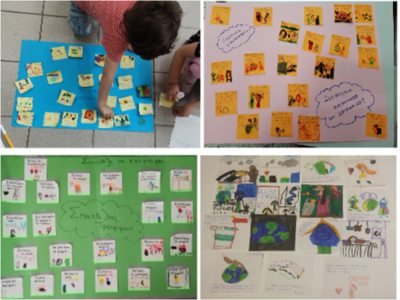
Understanding the problem
The problem of food waste was approached by weighing and recording the quantities of the food children did not consume at lunch. In an attempt to identify from which category of waste most of the garbage arose, they divided their records into 3 categories: organic waste, recyclables, and waste that ends up in the landfill. The children, carefully observing the results (Google docs) that arose through their active involvement in the experiential action, found that the same happened at home in larger quantities. Fruit and vegetable that were not “pretty” or were half-eaten as well as other leftovers in their lunch bowls often ended up in the trash. This finding sensitised the children to find ways to deal with the problem of food waste. The children proposed the following solutions:
- Make a compost bin,
- Reuse the leftovers (a leftovers recipe book generated through their creative proposals),
- Share their lunch,
- Reuse food scraps to make sustainable artwork,
- Smaller food portions,
- Make a board game (goal: food waste reduction),by using the intervasion kit ,akey makey
- Make escape rooms to share their knowledge by teaching others through game-based learning.
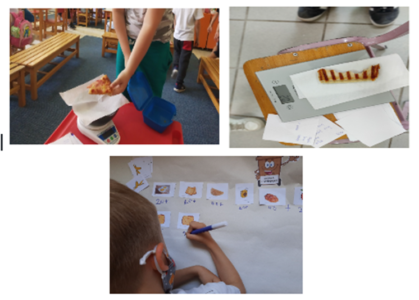
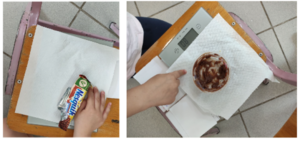
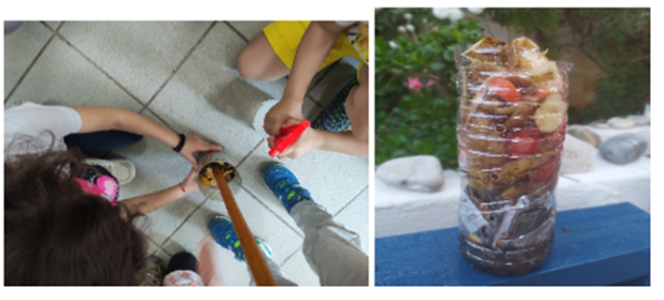
Looking for solutions to reduce food waste
The children looked for solutions in order to deal with this problem both at school and at home, trying to sensitize their immediate family environment. A collaborative book was created to remind everyone that every problem can be dealt with in different ways. Smart solutions, easily applicable and implementable were proposed by the children proving their awareness of the subject. While they expressed their desire to actively contribute to the adoption of a new attitude towards the problem of mindless consumption that burdens the sustainability of our planet.
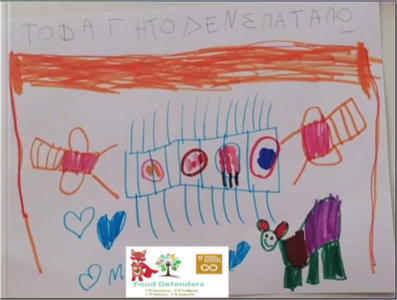
Book Creator | Λέμε όχι στη σπατάλη τροφίμων
Recipe book
Throughout the course of the action, the children's parents actively participated, supporting the missions assigned by the teachers to the children. One of the solutions that the children found, was the creative reuse of these foods (fruits, vegetables and other leftover foods), not only at school but also at home. Together with their parents, they drew pictures of food left in the fridge, which were not eaten, and then came up with creative delicious recipes that were well-loved, creating an original leftovers recipe book.
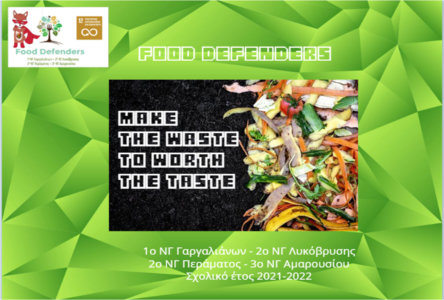
Book Creator | Make waste to worth the taste
Creating a Sustainable Work of Art
Through this action, the children discovered new ways of alternative and creative utilization of things that may be considered leftovers, but by letting their imagination and creativity free, they were transformed into tools of visual expression. The implementation of this action which was carried out was the "Actions for ... the hungry", organized by ActionAid under the title "The power on your plate. Food and Climate Change. A campaign for food and climate change. Student Action Week 2022.” , satisfied the children's endless quest to find ways to process and reuse all foods including those not consumed by humans.
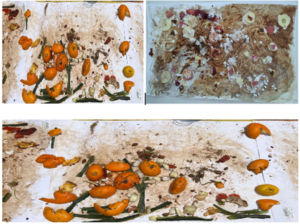
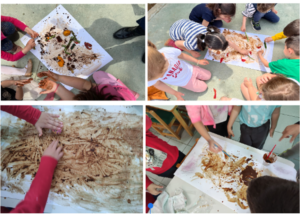


The food on our plate has a story to tell about the food miles it traveled to get from the field to our plate and be eaten by us. Children through their visual creations "come alive" presenting the solutions to the problem of food waste. The results of their compositions could be paintings of a Sustainable Art museum, which will chronicle the milestones of food and foodstuffs with the aim of raising awareness of the planet, facing the problem of food waste!
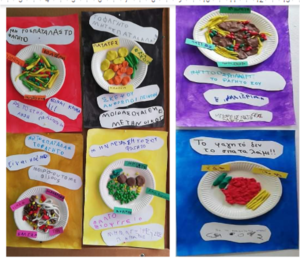

Board Game
The main objective of the board game was to increase and develop an awareness of food waste issues. Children created the board of the game and the players by using recycled and useless materials. They created the path of the game, set up rules.The board game represented children's ideas. The goal was for the players to collect cards depicting food packages, dairy products, vegetables, fruits, etc. At the end of the game, the players were asked to sort the trash in the appropriate bin (brown, green, blue).

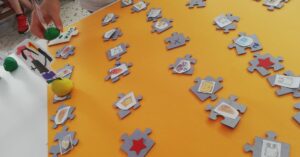
Makey Makey invention kit was used to connect the digital world with the real one. Makey Makey: is an invention kit designed to connect everyday objects to computer keys. Using a circuit board, alligator clips, and a USB cable. So for the board game children connect the cards they created with aluminium foil and the alligator clips, so "when anyone touches the aluminium foil, makes a connection and MaKey MaKey sends to the computer a keyboard message. The computer just thinks MaKey MaKey is a regular keyboard. Therefore it works with all programs and webpages, because all programs and webpages take keyboard and mouse input.”Moreover children used the makey makey app "Audio Sampler" where they recorded their voices and connected them with the cards of the board game.
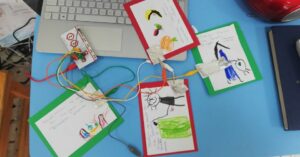
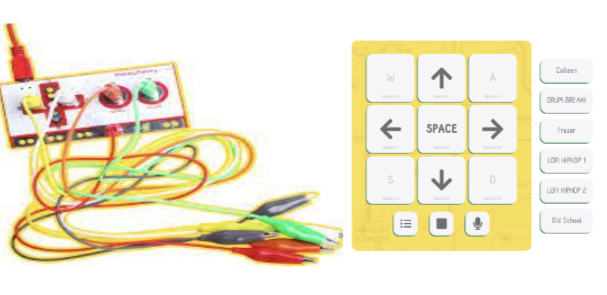
The promises of food defenders
The food defenders, our students, wearing their masks and bracelets made their own promise.
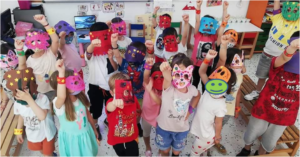
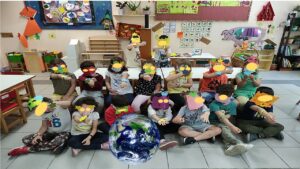
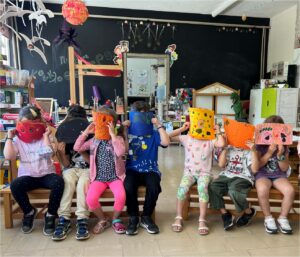
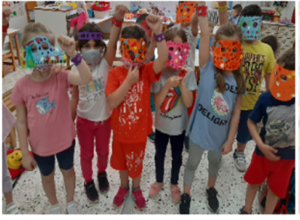
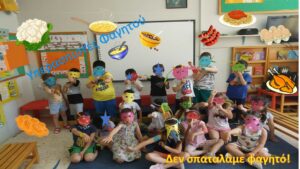
They said a strong NO to food waste, wanting to protect the environment and make other people in their immediate environment aware.
The children, the Food Defenders, spoke to us in a simple and understandable way about the responsibility we have towards the environment and how we can contribute to reducing food waste by being careful how we treat the food we eat! Through their visual interventions, they suggested that we plan our meals before we go shopping, not to buy more than we need, to share large portions of food and to be creative with leftover food. The Food Defenders wish to contribute to the reduction of food waste through the development of a food system (production in relation to real consumption needs and not overconsumption) that will respect the planet.

Evaluation – Outcomes
The Food Defenders evaluated their knowledge of food waste reduction and the necessity of zero waste through game-based learning. This project used Escape Rooms to foster learning outcomes for students. Storytelling and narration were parts of the mission which the players tried to accomplish. Participants in the game transfer their knowledge into the game context and are lured into the story to solve particular problems and achieve zero waste by disclosing the hidden phrase.
The Escape Room game
The 1st mission – Category sorting activity
Children had to collect only organic waste that people cannot consume (e.g. banana peel) and deposit them in the correct bin (brown bin) to get the clues (there were ten clues) to solve the final puzzle. Each letter of the alphabet had a symbol that stood for a letter (the hidden phrase was FOODY WASTY).

The 2nd mission – Crack the code
Mission 2 was a mix of a kinetic game with coding elements. Children had to follow the route, work together, carrying cards and matching them with the corresponding numbers according to the given match (number – picture) to solve the puzzler and get the clues.

The 3rd mission – Code through art
Five paintings of Magritte were selected (The Son of Man, 1946, The Listening Room, 1958, Apple Couple, Fine realities 1964, The Idea / L’idée). All teams played at the same time. They had to make their own board/puzzler and compare it with the other boards to figure out the common element. Through pixel art, they had to make their apple using caps to get the next clues.
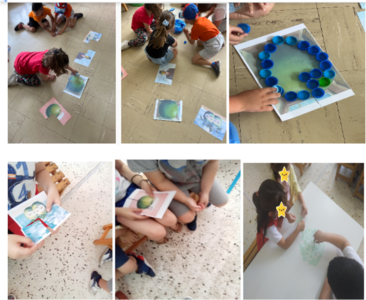
The 4th mission – Just quiz it
Students had to solve a digital quiz (questions and answers were recorded) about the problem of food waste and how to reduce it. It was designed by the children of one of the partner schools, using Genially online tools. Each group had to answer 10 questions to get the clues.
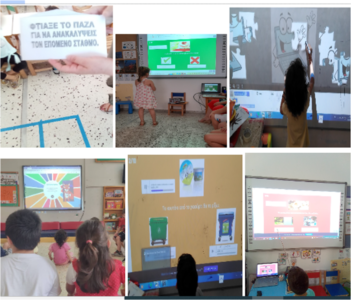
The 5th mission – Crack the banana code
This mission was divided into two parts. First, the children had to watch and listen to a message by creating a tangible interface circuit through Makey Makey Invention Kit. Then they had to put five pictures in a row. To match the pictures with the bananas, connect them with Makey Makey in Scratch to reveal the message and get the clues.
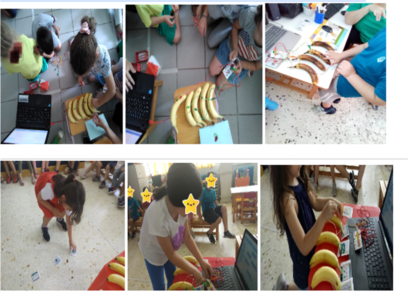
The last mission – Training Foody Wasty
Students in the last mission had to train the Edison robot. In this collaborative activity, the robot had the role of the mayor of the city and for the needs of the game, he was Foody Wasty. Foody Wasty had to properly sort waste by placing it in the appropriate bins and stop throwing it all in the green bin. The teams explored, experimented and collaborated on each decision. They chose how they would guide Foody Wasty to the correct bin. The suggestions of the students of the collaborating kindergartens after their experiments were:
- Use the TV remote control to guide Foody Wasty, whose remote control was activated by children hovering over the corresponding barcode.
- The utilization of EdScratch software was extremely easy even for young ages. EdScratch is based on the drag-and-drop block system. The code was as long as they clapped, Foody Wasty moved forward and as soon as they stopped clapping, he turned 90 degrees to the left. During the procedure, the children discovered that Foody Wasty’s response to the sound was “better” when they tapped their feet on the floor instead of clapping their hands.
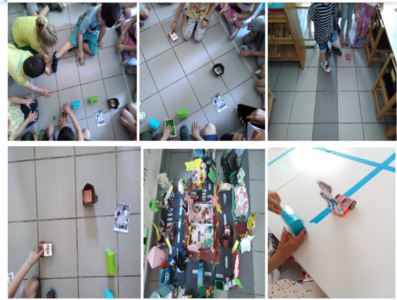
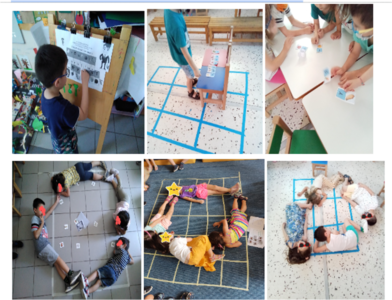
The routes were drawn on the floor/table with tape. Each group pre-decided how to guide the robot to the correct bin by clapping or using a remote control. Through this process, Foody Wasty became aware and adopted a new attitude towards the environmental issue of food waste, which increases our environmental footprint.
Conclusions
The educational activity focused on implementing an interdisciplinary approach based on STEAM education as it interacts with sustainable development goals and the broader philosophy of sustainable education. The children were allowed to cultivate skills related to creativity, critical thinking, collaboration, problem-solving, and communication. The children of the partner schools expressed their opinions and concerns about food waste, looked for solutions, and tried to change their attitudes. They gained new knowledge, cultivated skills, and adopted new attitudes towards the environment contributing to the reduction of food waste. They utilised technology and recognised its added value. They participated in a collaborative game Escape Rooms and became both designers and players of the game. In the end, children were asked the same question: What is “Food Waste,” and they were asked to recapture their thoughts visually. The recordings led us to the conclusion that the students did not simply understand the concept of food waste, but through the visual representation of the post-tests, we observed their awareness of the environmental issue of overconsumption that burdens the sustainability of our planet. By asking them to explain how and why their thinking has changed, they are allowed to develop their reasoning skills while developing active citizenship skills. Children are growing up in a world with multiple environmental problems. It is therefore essential that they are explicitly taught the skills of critical thinking and problem solving, effective communication, collaboration, as well as creativity and innovation, to make sure that they are well equipped to take initiative for a better world (Trilling & Fadel, 2009).

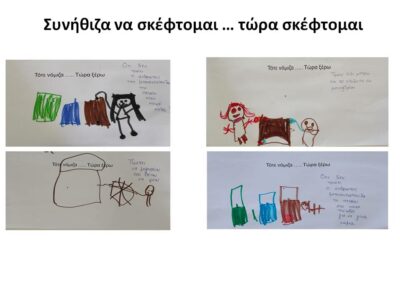
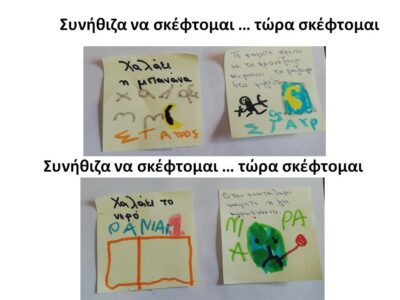

This was followed by the recording of the visual impression by the teachers. The specific recordings were also the post test of the action utilizing the thinking routine of the Visible Thinking approach of the Project Zero research group of Harvard University (Visible Thinking) "I used to think ... Now I think".
[1] http://www.pz.harvard.edu/resources/i-used-to-think-now-i-think
*This project could not be implemented without the collaboration and contribution of our motivated colleagues Garyfalia Terizaki (1st Kindergarten of Gargaliani), Eleni Spantidaki (2nd Kindergarten of Lykovrisi), Konstantina Papadogkona, Vaia Archonti, Katerina Rentzepi, Angeliki Voulgaraki (2nd Kindergarten of Perama).
The presentation of our project
https://view.genial.ly/636f9fa66ac2660013e7144f/presentation-191122food-defenders

Well done girls!!!
Please log in or sign up to comment.